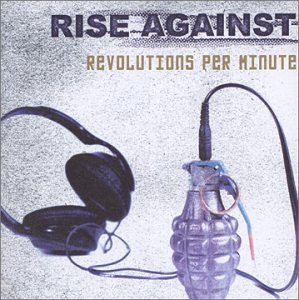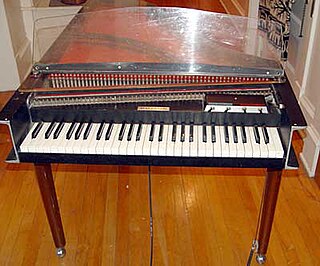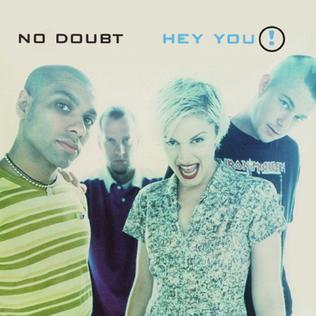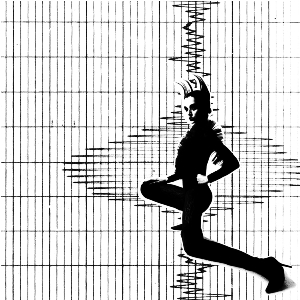Pop music is a musical genre.
Pop music may also refer to:
- Popular music, a number of musical genres having wide appeal
- Pop Music, a 1996 album by Iggy Pop
- "Pop Music", a 2017 song by Poppy from Poppy.Computer
Pop music is a musical genre.
Pop music may also refer to:
Bubblegum is pop music in a catchy and upbeat style that is marketed for children and adolescents. The term also refers to a more specific rock and pop subgenre, originating in the United States in the late 1960s, that evolved from garage rock, novelty songs, and the Brill Building sound, and which was also defined by its target demographic of preteens and young teenagers. The Archies' 1969 hit "Sugar, Sugar" was a representative example that led to cartoon rock, a short-lived trend of Saturday-morning cartoon series that heavily featured pop rock songs in the bubblegum vein.
Pop-punk is a rock music fusion genre that combines elements of punk rock with power pop or pop. It is defined by its fast-paced, energetic tempos, and emphasis on classic pop songcraft, as well as adolescent and anti-suburbia themes. It is distinguished from other punk-variant genres by drawing more heavily from 1960s bands such as the Beatles, the Kinks, and the Beach Boys. The genre has evolved throughout its history, absorbing elements from new wave, college rock, ska, hip hop, emo, boy band pop and even hardcore punk. It is sometimes considered interchangeable with power pop and skate punk.

Revolutions per Minute is the second studio album by American punk rock band Rise Against, released on April 8, 2003, by Fat Wreck Chords. After establishing a fanbase with their 2001 debut, The Unraveling, the band members wanted to record an album that distinguished them from other Fat Wreck Chords bands of the time. They chose Bill Stevenson and Jason Livermore to produce the album, with whom they developed a strong rapport. Recording took place from November to December 2002 at The Blasting Room in Fort Collins, Colorado.
The Billboard charts tabulate the relative weekly popularity of songs and albums in the United States and elsewhere. The results are published in Billboard magazine. Billboard biz, the online extension of the Billboard charts, provides additional weekly charts, as well as year-end charts. The two most important charts are the Billboard Hot 100 for songs and Billboard 200 for albums, and other charts may be dedicated to a specific genre such as R&B, country, or rock, or they may cover all genres. The charts can be ranked according to sales, streams, or airplay, and for main song charts such as the Hot 100 song chart, all three data are used to compile the charts. For the Billboard 200 album chart, streams and track sales are included in addition to album sales.
Country pop is a fusion genre of country music and pop music that was developed by members of the country genre out of a desire to reach a larger, mainstream audience. Country pop music blends genres like rock, pop, and country, continuing similar efforts that began in the late 1950s, known originally as the Nashville sound and later on as Countrypolitan. By the mid-1970s, many country artists were transitioning to the pop-country sound, which led to some records charting high on the mainstream top 40 and the Billboard country chart. In turn, many pop and easy listening artists crossed over to country charts during this time. After declining in popularity during the neotraditional movement of the 1980s, country pop had a comeback in the 1990s with a sound that drew more heavily on pop rock and adult contemporary. In the 2010s, country pop metamorphosized again with the addition of hip-hop beats and rap-style phrasing.

Baroque pop is a fusion genre that combines rock music with particular elements of classical music. It emerged in the mid-1960s as artists pursued a majestic, orchestral sound and is identifiable for its appropriation of Baroque compositional styles and dramatic or melancholic gestures. Harpsichords figure prominently, while oboes, French horns, and string quartets are also common.
Pop rap is a genre of music fusing the rhythm-based lyricism of hip-hop music with pop music's preference for melodious vocals and catchy tunes emphasizing on pop like productions and structure. The lyrics are often positive, with choruses similar to those heard in pop music. This genre gained mainstream popularity during the 1990s, though the influences and roots of pop rap can trace back to late-1980s hip-hop artists such as Run-DMC, LL Cool J, and Beastie Boys.

A jukebox musical is a stage musical or musical film in which a majority of the songs are well-known, pre-existing popular music songs, rather than original music composed for the musical.

"Hey You!" is a song recorded by American rock band No Doubt. It was released as the seventh and final single from their third studio album Tragic Kingdom (1995). The single was released as a CD single in the Netherlands on February 23, 1998. It is the final single to feature content from original keyboardist Eric Stefani, who left the group in 1995 due to creative issues.
Popular music is music with wide appeal that is typically distributed to large audiences through the music industry. These forms and styles can be enjoyed and performed by people with little or no musical training. As a kind of popular art, it stands in contrast to art music. Art music was historically disseminated through the performances of written music, although since the beginning of the recording industry, it is also disseminated through recordings. Traditional music forms such as early blues songs or hymns were passed along orally, or to smaller, local audiences.

Leprous is a Norwegian progressive metal band from Notodden, formed in 2001. The group was founded by singer and keyboardist Einar Solberg and guitarist Tor Oddmund Suhrke.
Malaysian popular music, sometimes called shortly Malaysian pop or abbreviated as M-pop, refers to popular music forms in Malaysia. Although popular music in various languages such as Mandopop are popular and have been produced in Malaysia, Malaysian pop refers to music recorded primarily in the Malay language in Malaysia.
City pop is a loosely defined form of American music-influenced Japanese pop music that emerged in the late 1970s and peaked in popularity during the 1980s. It was originally termed as an offshoot of Japan's Western-influenced "new music", but came to include a wide range of styles – including funk, disco, R&B, AOR, soft rock, and boogie – that were associated with the country's nascent economic boom and leisure class. It was also identified with new technologies such as the Walkman, cars with built-in cassette decks and FM stereos, and various electronic musical instruments.

Moriah Rose Pereira, known professionally as Poppy and formerly as That Poppy, is an American singer, songwriter, musician, and YouTuber. She first earned recognition for starring in surreal performance art videos on YouTube as an uncanny valley-like android who commented on and satirized internet culture and modern society. She is known for her experimentality and versatility with her artistry and music.

Poppy.Computer is the debut studio album by American singer and songwriter Poppy. It was released on October 6, 2017, by Mad Decent. The album's songs were recorded with Simon Wilcox, Titanic Sinclair, Chris Greatti and Ryosuke Sakai. It is heavily influenced by Japanese music and culture and is an art pop record. The album was included in Rolling Stone's list of best pop albums in 2017.

The discography of American singer Poppy consists of five studio albums, one reissue, three soundtrack albums, six extended plays (EPs), 36 singles, nine promotional singles, and 38 music videos. Signed to Island Records in 2014, she would release her debut single "Everybody Wants to Be Poppy" in June 2015. Her debut EP, Bubblebath, would go on to be released in February 2016, and included the critically acclaimed single "Lowlife".

Am I a Girl? is the second studio album by American singer and songwriter Poppy. It was released on October 31, 2018, by Mad Decent. Musically, it's primarily a dance-pop record that would later expand on the nu metal genre. The album was recorded with several producers and co-writers including Vaughn Oliver, Wax Motif, Fernando Garibay, Zakk Cervini and more.

"X" is a song by American singer Poppy. It was released on October 25, 2018 by Mad Decent as the fifth and final single from her second studio album Am I a Girl? (2018). The song was written by Poppy, Titanic Sinclair, Chris Greatti and the producer Zakk Cervini. Musically, the song explores heavy metal, a musical departure for Poppy at the time.

I Disagree is the third studio album by American singer-songwriter Poppy. it was released on January 10, 2020, as her first album with Sumerian Records following her departure from Mad Decent, as well as her final collaborative project with Titanic Sinclair before the end of their creative partnership in 2019.

Flux is the fourth studio album by American singer-songwriter Poppy. It was released on September 24, 2021, through Sumerian Records. The album was produced by Justin Meldal-Johnsen and features a more organic sound in comparison to her previous album, I Disagree. The album received positive reviews.